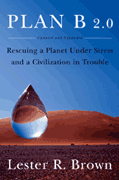|
|
|||
 |
Get GP free via email ! |
|
|
Reduce WasteAn article about waste reduction success stories and ways to reduce waste in the future.
REDUCE WASTE Reuse Reduces Waste Compared to RecyclingBeyond measures that encourage the recycling of materials are those that encourage the reuse of products such as beverage containers. Finland, for example, has banned the use of one-way soft drink containers. Canada's Prince Edward Island has adopted a similar ban on all non-refillable beverage containers. The result in both cases is a sharply reduced flow of garbage to landfills. A refillable glass bottle used over and over requires about 10% as much energy per use as an aluminum can that is recycled. Cleaning, sterilizing, and relabeling a used bottle requires little energy, but recycling cans made from aluminum, which has a melting point of 660 degrees Celsius (1,220 degrees Fahrenheit), is an energy-intensive process. Banning non-refillables is a win-win-win option--cutting material and energy use, garbage flow, and air and water pollution.
REDUCE WASTE BY
|
|||||||||||||||||||||||||||||||||||||||||||||||||||
|
Another way to reduce waste is to systematically cluster factories so that the waste from one process can be used as the raw material for another. NEC, the large Japanese electronics firm, is one of the first multinationals to adopt this approach for its various production facilities. In effect, industrial parks are being designed, both by corporations and governments, specifically to combine factories that have usable waste products. Now in industry, as in nature, one firm's waste becomes another's sustenance. |
|
Government procurement policies can be used to dramatically boost recycling. For example, when the Clinton administration issued an Executive Order in 1993 requiring that all government-purchased paper contain 20% or more "post-consumer content" by 1995 (increasing to 25% by 2000), it created a strong incentive for paper manufacturers to incorporate wastepaper in their manufacturing process. Since the U.S. government is the world's largest paper buyer, this provided a burgeoning market for recycled paper.
New technologies that are less material-dependent also reduce materials use. Cellular phones, which rely on widely dispersed towers or on satellites for signal transmission, now totally dominate telephone use in developing countries, thus sparing them the investment in the millions of miles of copper wires that had to be made by countries that industrialized in an earlier era.
One industry whose value to society is being questioned by the environmental community is the bottled water industry. The World Wide Fund for Nature, an organization with 5.2 million members, released a study in 2001 urging consumers in industrial countries to forgo bottled water, observing that it was no safer or healthier than tap water, even though it can cost 1,000 times as much.
WWF notes that in the United States and Europe there are more standards regulating the quality of tap water than of bottled water. Although clever marketing in industrial countries has convinced many consumers that bottled water is healthier, the WWF study could not find any scientific support for this claim. For those living where water is unsafe, as in some Third World cities, it is far cheaper to boil or filter water than to buy it in bottles.
Phasing out the use of bottled water would eliminate the need for billions of plastic bottles and the fleets of trucks that haul and distribute the water. This in turn would eliminate the traffic congestion, air pollution, and rising carbon dioxide levels from operating the trucks.
A brief review of the environmental effects of gold mining raises doubts about whether the industry is a net benefit to society. In addition to the extensive release of mercury and cyanide into the environment, annual gold production of 2,500 tons requires the processing of 750 million tons of ore—second only to the 2.5 billion tons of ore processed to produce 1 billion tons of raw steel.
|
Over 80% of all the gold mined each year is used to produce jewelry that is often worn as a status symbol, a way of displaying wealth by a tiny affluent minority of the world's people. Birsel Lemke, a widely respected Turkish environmentalist, questions the future of gold mining, wondering whether it is worth turning large areas into what she calls "a lunar landscape." She is not against gold per se, but against the deadly chemicals—cyanide and mercury—that are released in processing the gold ore. |
|
To set an honest market price for gold would mean imposing a tax on it that would cover the cost of cleaning up the mercury and cyanide pollution from mining plus the costs of landscape restoration in mining regions. Such a tax, which would enable the price of this precious metal to reflect its full cost to society, would likely raise its price severalfold.
Another option for reducing the use of raw materials would be to eliminate subsidies that encourage their use. Nowhere are these greater than in the aluminum industry. For example, a study by the Australia Institute reports that smelters in Australia buy electricity at an astoundingly low subsidized rate of 0.7 to 1.4 cents per kilowatt-hour, while other industries pay 2.6 to 3.1 cents. Without this huge subsidy, non-refillable aluminum beverage containers might not be cost-competitive. This subsidy to aluminum also indirectly subsidizes both airlines and automobiles, thus encouraging travel, an energy-intensive activity.
The most pervasive policy initiative to lower material use in the economy is the proposed tax on the burning of fossil fuels, a tax that would reflect the full cost to society of mining coal and pumping oil, of the air pollution associated with their use, and of climate disruption from their associated greenhouse-gas emissions. A carbon tax will lead to a more realistic energy price, one that will permeate the energy-intensive materials economy and reduce materials use. (Related Lester Brown article: Tax Shifting.)
REDUCE WASTE
The challenge in building an environmentally and economically sustainable materials sector is to ensure that the market is sending honest signals. In the words of Ernst von Weizsäcker, "The challenge is to get the market to tell the ecological truth." To help the market to tell the truth, we need not only a carbon tax, but also a landfill tax so that those generating garbage pay the full cost of getting rid of it and product manufacturers are properly incentivized to reduce waste in the first place.
| Lester Brown is founder and president of Earth Policy Institute. He has been described by the Washington Post as "one of the world's most influential thinkers" and as "the guru of the global environmental movement" by The Telegraph of Calcutta. The above article was excerpted from Chapter 12 of his book Plan B 2.0 – Rescuing a Planet Under Stress and a Civilization in Trouble. (See Grinning Planet's book review below.) |
Know someone who might like article about how we can reduce waste? Please forward it to them.
|
Search Amazon.com for .... More articles and resources on.... |
|
FREE AUDIO CLIPS

|
Plan B 2.0 Rescuing a Planet Under Stress and a Civilization in Trouble by Lester R. Brown |
|
|
REVIEW
Doctors generally impress us with their knowledge of how the human body works. Similarly impressive is Lester Brown's broad knowledge of how the earth's systems work and the ills they are suffering today. Falling water tables, soil erosion, and advancing deserts threaten our agricultural lands; drinking water shortages afflict much of the world's people and threaten to affect many more in the years to come; the peaking of global oil supplies threatens the world's economy; the collapse of many of the planet's fisheries threatens one of the world's best protein sources; and global warming threatens just about everything.
To purchase this book, visit the |

To purchase this book, visit the
See more ... Search Amazon.com |
Back to . . .
Productivity Cartoon / Efficiency Joke
Jokes/Cartoons (non-eco)
ADVERTISEMENT
|
||||
|
View on Amazon.com: Cradle to Cradle: Today's "cradle to grave" manufacturing model dates back to the Industrial Revolution and casts off as much as 90 percent of the materials it uses as waste, much of it toxic. The authors argue that products and processes should be designed so that wastes and worn-out products serve as useful manufacturing inputs, not trash and pollution.
"Good house keeping practices in industries can reduce 30% of waste and thereby 30% of the cost of waste management." — Sumith Pilapitiya
View on Amazon.com: True to Yourself: Many leaders of small businesses want to serve the common good, but everyday pressures can make that extremely difficult. What tools are available to lead an organization that's obligated to more than the financial bottom line? True to Yourself provides potent, practical advice for leaders looking to make their small business profitable and sustainable. THE STORY OF STUFF — In this 20-minute Flash video/animation, Annie Leonard tells us the Story of Stuff---how consumer goods get made and disposed of. She visually narrates the tale with fun, quirky graphics that help illustrate concepts and keep our brains plugged in. Her goal is to disabuse us of the mantra "I shop, therefore I am," highlighting the negatives that go with our consumeristic culture: resource extraction and environmental degradation; chemicals and body burden; even personal unhappiness. At the end of the clip, we hear about a few sustainable solutions, and the companion web site continues on in that vein. Leonard occasionally exaggerates, and a few of her specifics are a bit off, but the general charges here are right on. Animation by FreeRangeGraphics. Go there
|
| > | ||||||||
| > |  |
Get Grinning Planet free by email | Send this page to a friend or two | |||||
| > |
Issue Number 170 Copyright 2007 © Mark Jeantheau — All rights reserved. More info |
|||||||
|
|
|
|||||||
|